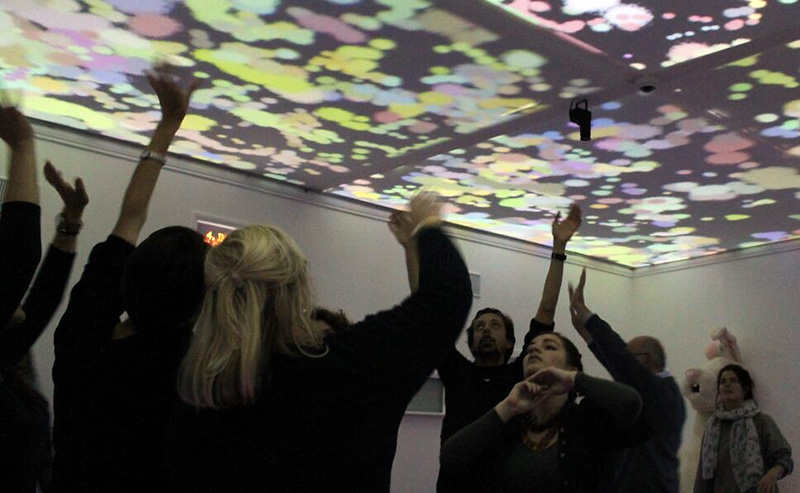 Twenty people, one room, and a seven foot rabbit with questionable intentions, Invisible Treasure describes itself as an ‘electrifying exploration of human relationships, power structures and individual agency’. There are no actors and no plot as such, just an enigmatic display board on one wall offering cryptic instructions which the audience must decode and carry out together in order to progress to the next ‘level’ of the experience.
Twenty people, one room, and a seven foot rabbit with questionable intentions, Invisible Treasure describes itself as an ‘electrifying exploration of human relationships, power structures and individual agency’. There are no actors and no plot as such, just an enigmatic display board on one wall offering cryptic instructions which the audience must decode and carry out together in order to progress to the next ‘level’ of the experience.
The atmosphere in the room is one of carefully constructed foreboding. The rabbit is an inspired cross between Alice in Wonderland and Orwell’s 1984, its eyes flashing different colours depending on its mood, and its mouthpiece, the display board, goading the audience with commands like ‘behave’, ‘conform’ and ‘Eugenie Knows’ as they get closer or further away from unravelling the tasks.
Each challenge is woven together with an inventive balance of lighting, sound, and technology. Moods throughout the performance move seamlessly from panicked activity as timers count down and lights flash amber or red in displeasure, to moments of serene contemplation as fluorescent digital paint flows across the ceiling, mirroring the movements of the audience below. To lighten the mood and express his satisfaction the ambiguously motivated March Hare occasionally flashes green and white and shoots bubbles from his nose.
The real performance of the experience, however, comes from the audience members themselves who, without prompting, assume the roles of leader, director, follower, interrogator. It is easy to discern parallels with cultural explorations of social experiments that have come before – Lord of the Flies, Lost, the first half of any zombie film – which similarly confront the audience with existential questions like ‘if this were real, would I survive?’, ‘Who can I trust?’ and ‘Who is Eugenie, and what does she know?’.
It is this element of the experience that seems to hold the real purpose of the show. It quickly becomes clear that success is only possible as a group, but each participant is encouraged to question their individual role in that accomplishment and their experience of it, ranging from the enjoyment of successful teamwork to irritation and rebelliousness as the group is challenged and different members vie for leadership. There is no definitive comment offered on these dynamics, merely a reminder of their existence, which perhaps is enough. The audience leaves conscious that they have unwittingly played a part not only in an interactive digital experience, but also in a mild social experiment examining impromptu power structures, the agency of the individual, and cooperation and competition in group dynamics.
The experiences also offer the audience more practical insights, like how difficult it is to form a human triangle in the dark.
The beauty of any interactive, audience-led performance is that the experience will be unique for each group, often depending on the politeness, collaboration and/or general sobriety of its members. For this performance there are a few moments of inactivity and confusion, leaving the audience wondering whether their actions are truly moving the performance forward and to what extent the messages, lights and sounds are predetermined. These lulls, however, do not last long and no sooner have the questions arisen than the performance moves on, either by the audience’s ingenuity or the grace of the omnipotent benefactor. We hope for the former.
But if the audience are left questioning their success in some of the tasks, Invisible Treasure has one final act to reveal. The first and second acts (arrival and participation) take place entirely within ‘the system’, overseen by the furry, bubble-blowing megalomaniac. The third act, however, takes place outside of this system. It allows the audience to explore its artifice, to see the complex technology at work and to view their experience from an alternative perspective. It is this third act that gives the first and second their meaning, keeping them from fading into superficial novelty. Where a good illusionist keeps their audience guessing and questioning by withholding their secrets, conversely, Invisible Treasure offers the same level of intrigue by revealing all and laying bare its very construction. After seeing and examining everything, both inside and out, the audience have nothing left to question but their own actions and behaviours – memories that will stick with them long after the performance has ended.

